

Guidelines for submitting articles to Santa Rosalia Today
Hello, and thank you for choosing Santa Rosalia.Today to publicise your organisation’s info or event.
Santa Rosalia Today is a website set up by Murcia Today specifically for residents of the urbanisation in Southwest Murcia, providing news and information on what’s happening in the local area, which is the largest English-speaking expat area in the Region of Murcia.
When submitting text to be included on Santa Rosalia Today, please abide by the following guidelines so we can upload your article as swiftly as possible:
Send an email to editor@spaintodayonline.com or contact@murciatoday.com
Attach the information in a Word Document or Google Doc
Include all relevant points, including:
Who is the organisation running the event?
Where is it happening?
When?
How much does it cost?
Is it necessary to book beforehand, or can people just show up on the day?
…but try not to exceed 300 words
Also attach a photo to illustrate your article, no more than 100kb

Uncovering the Cabezo del Pino Roman site in La Unión
La Unión, Cabezo del Pino is the first Roman site of its type to be excavated in Spain
It´s excavation season in Murcia, and across the Region summer archaeological camps are snatching the  brief weeks of summer to excavate some of the important sites which litter the Region of Murcia, teams from Universities worldwide working alongside archaeological students, unearthing the Region´s past.
brief weeks of summer to excavate some of the important sites which litter the Region of Murcia, teams from Universities worldwide working alongside archaeological students, unearthing the Region´s past.
Having posted the info that there was an open day at the Roman Cabezo del Pino site in La Unión, we decided to track it down on the main Carretera between la Unión and Portmán, a task which proved a bit of an adventure as it was not at km3 as we´d been told, but km3.7 and with no signs to indicate any sort of activity it was only by joining forces with a lost Spanish family from Los Urrutias who were also on the same mission, that we eventually decided it could only be in one place, so parked the cars and set off down what looked like a promising track.
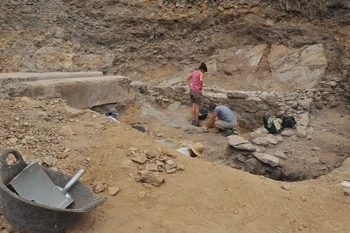 The track soon dwindled into crushed brush and the enthusiasm of the family with young children visibly waned as the terrain grew more difficult, then just as we´d all decided to give up and go to the archaeological museum in Portman instead, voices on the wind hinted that we were not alone, and suddenly there was the site, high on a ridge looking out over the bay of Portman.
The track soon dwindled into crushed brush and the enthusiasm of the family with young children visibly waned as the terrain grew more difficult, then just as we´d all decided to give up and go to the archaeological museum in Portman instead, voices on the wind hinted that we were not alone, and suddenly there was the site, high on a ridge looking out over the bay of Portman.
This site is the first Roman remains of its kind to have been excavated in Spain, the campaign being carried out by Juan Antonio Antolinos from Murcia University, and Christian Rico, professor of Roman History at the University of Toulouse-Le Mirail in France.
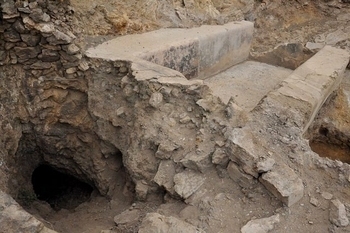 This area is part of the Sierra Minera, stretching from Portmán to Cartagena, rich mineral deposits holding a number of minerals, the most important of which is galena, yielding lead and silver. These same deposits litter the Murcian coastline, and similar mining activity took place further along the coast in Mazarrón, at the same time as this area was in operation.
This area is part of the Sierra Minera, stretching from Portmán to Cartagena, rich mineral deposits holding a number of minerals, the most important of which is galena, yielding lead and silver. These same deposits litter the Murcian coastline, and similar mining activity took place further along the coast in Mazarrón, at the same time as this area was in operation.
Although the hillsides today are stark and empty, littered with mining waste, crushed rocks and hardy esparto grass and scrub, when this site was in operation, between 200 AD and 100 AD, the hillsides would have been heaving with human activity, a reported 40,000 people engaged in manual mining across the Sierra Minera.
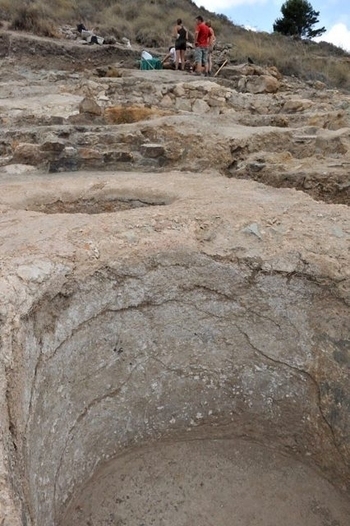 The historian Polibio visited this area in the second century before Christ, when the Romans occupied Cartagena, and reported on the scale of activity, quoting 40,000 workers, many of them slaves, as being involved in the mining activity, the silver yielded in this area being of particular richness, smelted and minted into silver coins which nourished the armies and tentacles of Rome, which at this point in history, were securely wrapped around Europe.
The historian Polibio visited this area in the second century before Christ, when the Romans occupied Cartagena, and reported on the scale of activity, quoting 40,000 workers, many of them slaves, as being involved in the mining activity, the silver yielded in this area being of particular richness, smelted and minted into silver coins which nourished the armies and tentacles of Rome, which at this point in history, were securely wrapped around Europe.
Concessions were sold to those who had a little money to invest in a mining enterprise, and there were many small businesses operating on these hillsides, manually extracting the raw materials which were processed, then sent down to the foundries which lined the Rambla below and into Cartagena for onward transportation across the Roman Empire.
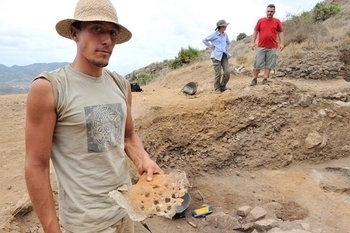 In the archaeological museum of Cartagena, there are a number of lead ingots which didn´t manage to complete the journey, recovered from shipwrecks found off the Cartagena coast, bearing the names and exploitation numbers of the concessionaries who mined and manufactured them, as well as examples of esparto grass basketware and tools recovered from the Roman Mines which lie enterred in the bowels of these hillsides.
In the archaeological museum of Cartagena, there are a number of lead ingots which didn´t manage to complete the journey, recovered from shipwrecks found off the Cartagena coast, bearing the names and exploitation numbers of the concessionaries who mined and manufactured them, as well as examples of esparto grass basketware and tools recovered from the Roman Mines which lie enterred in the bowels of these hillsides.
Mines honeycomb this whole Sierra, tunnels piercing the earth into underground galleries as the workers extracted minerals from the seams which run through the Sierra, earth movements millions of years ago having literally folded the earth into a number of layers, each with defined mineral structures.
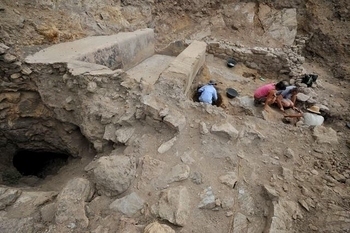 Material was mined right next to where it was processed, minimising the labour dedicated to moving too much bulk, the first stage being to reduce the rock to a mineral rich material ready for smelting.
Material was mined right next to where it was processed, minimising the labour dedicated to moving too much bulk, the first stage being to reduce the rock to a mineral rich material ready for smelting.
Gallena is a mineral which must be washed before smelting and what the archaeologists have found here is a site which processed the rock post-mining.
In order to extract the valuable minerals, mined materials were first crushed in pits, making them easier to process.
They were then washed to remove impurities, then finally passed through a decantation process to improve the concentration of the extracted minerals, before being sent down to the foundry for smelting.
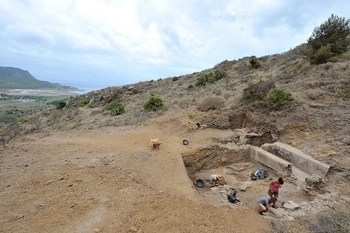 This site clearly shows the three stages and is remarkably complete, with washing troughs, crushing pits and decantation troughs spread across the hillside.
This site clearly shows the three stages and is remarkably complete, with washing troughs, crushing pits and decantation troughs spread across the hillside.
It´s difficult to believe that the remains are actually Roman, the troughs still intact and with their mortar lining holding its form, a material called "opus signinum". Pliny actually describes the manufacture of this material in his book, natural history, a material made by crushing broken ceramics and mortar, then compacted down hard with a rammer to make an impermeable and durable sealer.
And the testament to this durability is its perfect conservation on the hillsides of La Unión 2000 years later.
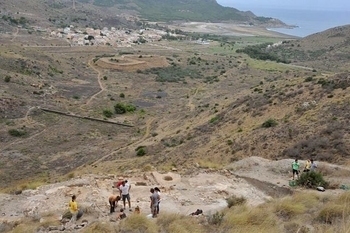 Professor Rico explained that the Murcian archaeologists involved in the project had prospected the entire hillsides of this area before selecting this particular site, having discovered good quantities of superficial Roman Pottery which indicated that the site may not have been destroyed by the miners who followed the Romans during the 2000 year period which had elapsed since they were mining in this location.
Professor Rico explained that the Murcian archaeologists involved in the project had prospected the entire hillsides of this area before selecting this particular site, having discovered good quantities of superficial Roman Pottery which indicated that the site may not have been destroyed by the miners who followed the Romans during the 2000 year period which had elapsed since they were mining in this location.
A more modern mine had cut through the end of part of the site, but much of what is now revealed had been buried by the subsequent mining activity.
It appears that the site was in operation for under a hundred years during the 2nd century BC, was then abandoned for a period of time, probably around 50 years and then the site used again for a few years, probably 30-40 years, possibly by a different concession before being abandoned.
These conclusions have been drawn from the pottery and artefacts recovered from the site, and by measuring the layers in which they were found.
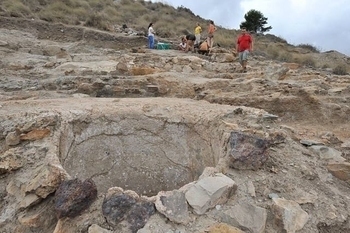 One of the big questions which remains to be answered is where the water came from to process these materials, as evidence has only been discovered so far of one storage tank which held 5.8 cubic metres of water, very little for an operation on the scale of activity suggested by this site.
One of the big questions which remains to be answered is where the water came from to process these materials, as evidence has only been discovered so far of one storage tank which held 5.8 cubic metres of water, very little for an operation on the scale of activity suggested by this site.
Professor Rico said that there are operations similar to this one in Greece, and evidence has been found there which suggests a water recycling process, but as much of this excavation still remains below ground, there is no indication yet as to how the various sections of the process were linked.
There are many more sites buried beneath these hillsides, but as usual, lack of financing for archaeological excavation restricts the amount of work which can be done.
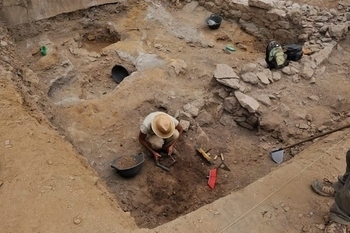 This project is financed by the Casa de Velázquez de Madrid, a French-funded research institute supported by the French Ministry for Foreign Affairs, in conjunction with the Autonomous Community of Murcia and Murcia University. The Professor said he has enough financing for three more seasons on the site, but that should be sufficient to complete the missing pieces of this puzzle and enable the Regional Government to open the site to public visits should it wish to do so.
This project is financed by the Casa de Velázquez de Madrid, a French-funded research institute supported by the French Ministry for Foreign Affairs, in conjunction with the Autonomous Community of Murcia and Murcia University. The Professor said he has enough financing for three more seasons on the site, but that should be sufficient to complete the missing pieces of this puzzle and enable the Regional Government to open the site to public visits should it wish to do so.
Next year the site will be open for visitors at the end of the three precious weeks dedicated to working on it for just one morning, but at least next year, well be able to give you detailed directions of how to get to this interesting and unique archaeological site so you can see for yourself what was happening on this hillside 2200 years ago.
If you´re interested in finding out more about this area, read the History of La Unión which tells the story all the way through. Click History of La Unión.
